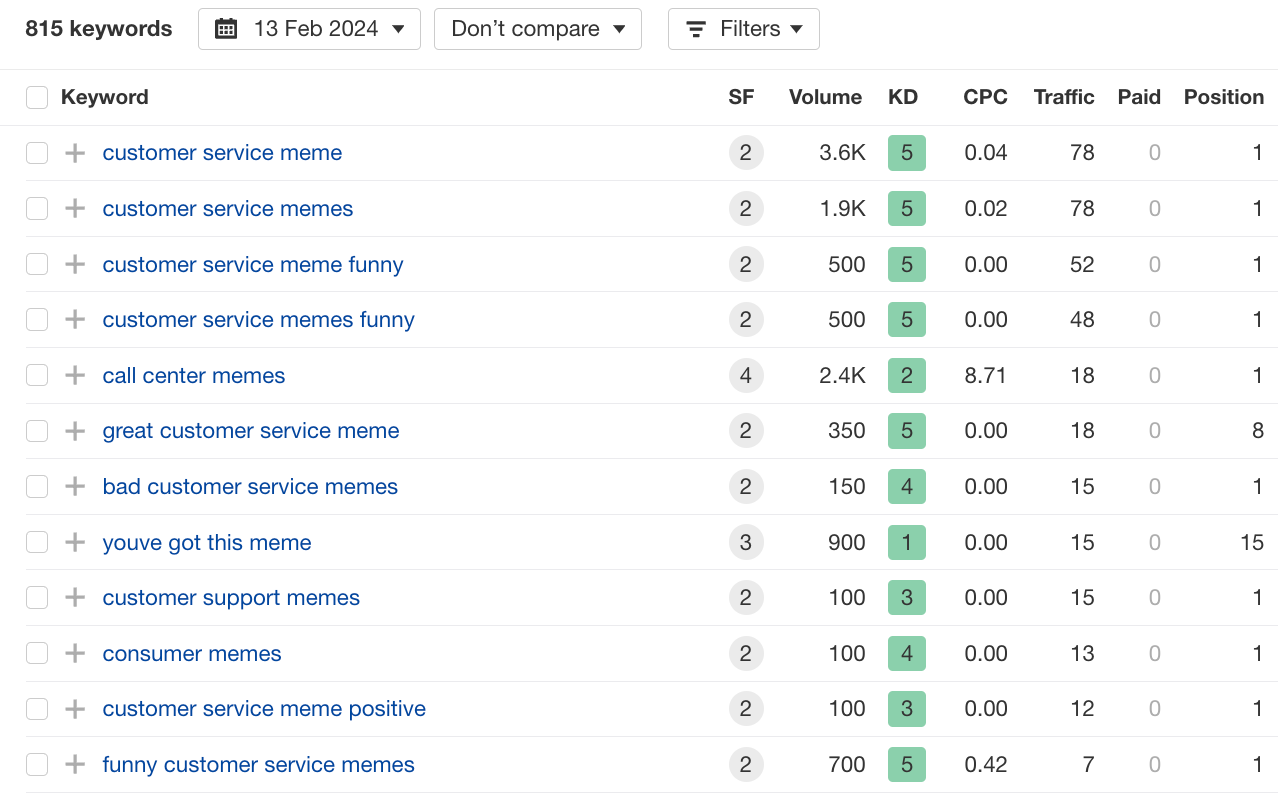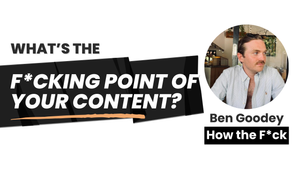(sorry)
Alright, alright, alright.
When I worked at SentiSum a few years back, I wrote an article to entertain our target audience during Customer Service Week.
It was a list of memes I found funny. And yeah, that bastard shot to #1 and still ranks there today.

Frankly, this is one case where I genuinely believe there was NO point. 1,000s of traffic per month...for nothing.
It has earned 5 or so organic backlinks, so that's a small win?
I guess?
But more importantly, the content:
- Targets the wrong audience (who's really Googling this?)
- Is unoriginal (I just gathered some memes together)
- Doesn't establish us as an authority on topics we'd want
- Has zero attempts at capturing traffic
It was fun and served its purpose for that week.
But long-term, this is not what I'd call "strategic" marketing.
Anyway, good news.
There's a big lesson in this 👇
→ "What's the F*cking Point?"
Before creating any content, this is a good question to ask.
(the cursing is optional—you may use the more vanilla, 'what is the purpose of writing this article?')
The answer to this question helps you deeply consider your reader and connect your content to their needs, which:
- Helps you decide what outcomes to expect.
- Helps you decide how much effort to put in.
- Helps you decide on the spice levels.
- Helps you get more conversions.
- Helps you decide on your tone.
- Helps you create a "next step".
In the rest of this newsletter, I wanna show my answer to this question for a type of content we all struggle with: TOFU.
"What is the f*cking point of top-of-funnel content?"
I feel this is a pretty challenging question.
So, let's dive in.
What’s the F*cking Point of "Top of Funnel" Content (in SEO)
First, what is "top-of-funnel" content?
To answer our question, we must first understand the reader.
What do we know about ToFu searchers?
✅ The searcher wants to learn, deepen their knowledge, and expand their thinking on this topic. They may even have a problem to solve, although what that is might not be clear yet.
✅ Depending on the concept they're learning, this is likely important to their job. This tells us they also want to look good at work, need to trust what they're reading, and could benefit from both basic and strategic knowledge. (Look into search mindset to learn why this is important).
✅ They're also not looking to buy anything and are very likely to be put off by salesy content right now (because...nobody loves a bait-and-switch article).
✅ Unless you're a well-known brand, this is also likely their first brush with your company. They're not going to immediately trust or care about you.
These all influence the "point" of this content:
So, what's the point of this content? And how does that influence the content we create?
So, we don't have their trust → Let's fix that.
They don't have any commercial intent → So, let's not force commercial content on them.
They do want a quality learning experience → Let's deliver that.
They also must remember us for a long time → So, let's try and wow them.
Knowing these goals, we can build our approach to achieving them:
1/ Be memorable
This audience has a long way to go before making a purchase. So, this isn't an opportunity to make boring, simple content with AI. The opposite is true.
You need to "wow" them. You need them to click "save". You need them to share this article with their team. You need to seer into their memory.
Here's how:
- Unique insights
- Earned insights
- Innovative thinking
- Controversial thinking
- New data/research
- Fancy illustrations
- 10/10 writing quality
I want it to be different. Unignorable.
Instead of writing another "ultimate guide", maybe you want to create a custom YouTube video to embed. Or maybe, you want to develop a unique framework for them to follow. Get creative.
2/ Build trust
This is their first brush with your company. You need to impress AND build trust.
How:
- Work with people they already trust (e.g. share insights from influencers).
- Humanize the content - share the author, their experience, and tell stories.
- Writing quality - write with confidence, cut the fluff & avoid over-optimising content for search.
To establish trust with top-of-funnel content, you can't palm this off to your junior writer.
3/ Capture them
It's tempting for the goal of all your content to be "book a demo". But there's no commercial intent here, so we need to avoid "kissing on the first date".
Instead, consider what the obvious next step might be for this reader.
- They've just read your article.
- Now they want to [XXX]
Whatever [XXX] is...create it and offer it to the reader as a download.
Most commonly, I'd use a super compelling research report. Something they can download to deepen their expertise, which also establishes us as thought leaders.
These emails fall into our email marketing—reducing the need for the content to be so memorable.
Other favourites?
- Templates
- Related content
- Follow on social media
Want to capture even more of the traffic?
Try paid traffic retargeting.
Most people don't know that you can set up LinkedIn ads to advertise to readers of a specific blog post. Let's say 5,000 people a month read Ahrefs' article "what is keyword research?" they could target specifically them with product-related ads on LinkedIn.
This is particularly powerful because you know what they recently searched (and therefore what's top of mind for them right now). That means you can make your offer hyper-relevant to their needs.
When you sit down and answer the question "What's the f*cking point of this content?" it forces you to:
- Properly consider your reader.
- Match content to opportunity.
- Set actually achievable goals.
Knowing the context and the goals = content with a chance of driving results.
—Benny
More from me:
- Learn to build your scalable content machine here.
- Dive into my library of 40+ fast-growth SEO case studies from 2023.
Thank you all for still buying these two. The interest still surprises me daily. ❤️


